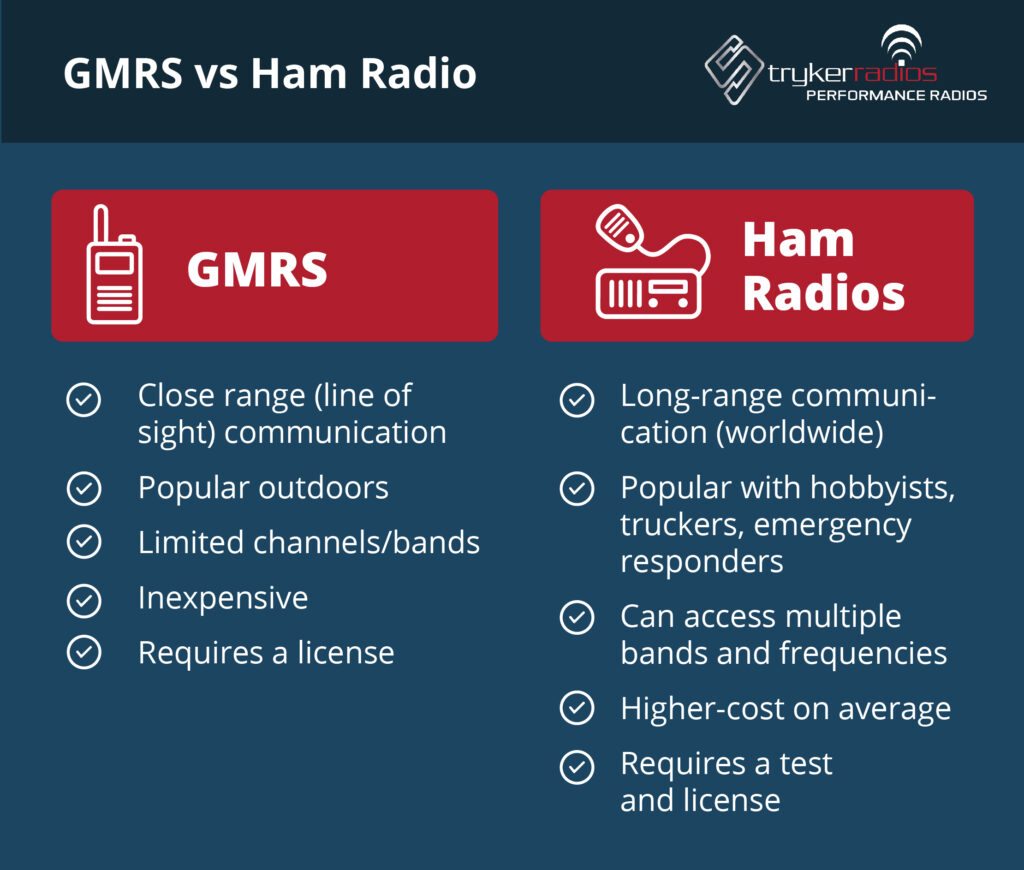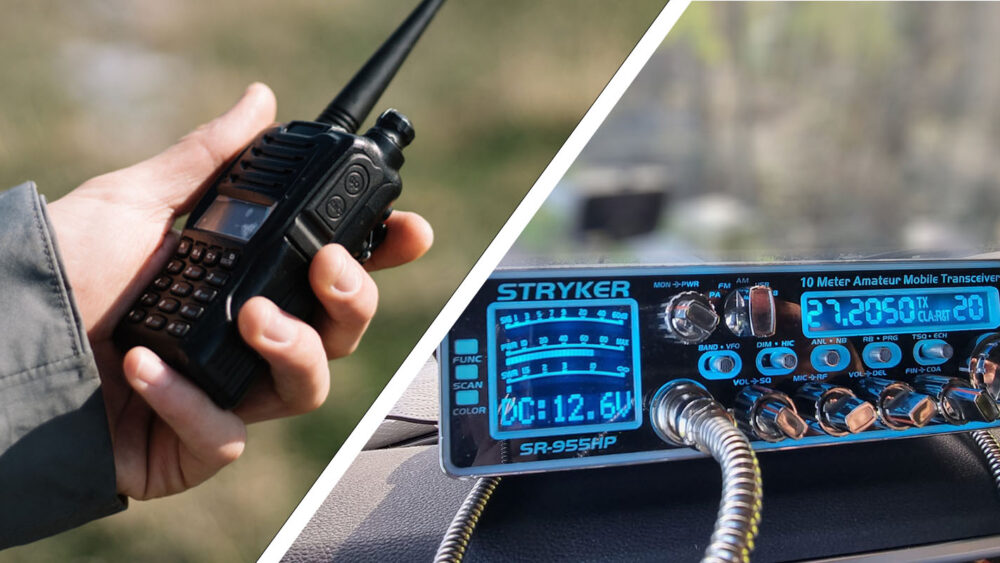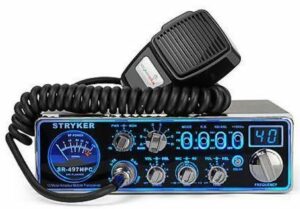Maybe you’re looking at putting a CB in your truck or vehicle or adding one at the house as a base station. Maybe you’re looking at replacing a radio you’ve been using for years. Maybe your job has changed, and your radio needs have changed along with it. Maybe there’s a better answer than another CB.
There are tons of YouTube videos. Some will tell you GMRS is the way to go. Some are all-in for CB radio. And of course, some say Ham radio is the only amateur radio you should consider. It seems, though, like everyone’s pushing their particular situation and preference. You need a simple, unbiased look at the options.
One thing that will simplify matters is to narrow the field. CB radio really isn’t the one-size-fits-all solution everybody thought. Unlicensed Citizen’s Band attracts users who clutter the channels and make necessary communication difficult. At times it can even seem irresponsible to provide real information over CB.
FRS, or Family Radio Service is definitely not an option. They’re limited to 2 Watts at best and have fixed antennae. They’re the lowest-powered amateur radio on the market, with the poorest reception and lowest audio quality. They’re easy to use, but they just can’t do what you need.
 What is a GMRS Radio?
What is a GMRS Radio?
Handheld GMRS, or General Mobile Radio Service radios are the next step up from FRS. The GMRS provides a middle-of-the-road option that works well for certain work environments and terrains.
In fact, GMRS radios can talk to FRS radios on certain channels like walkie-talkies, but that’s where the similarities end. GMRS radios can talk to some Ham radios too, but only on one Ham band. While Ham radios can communicate on a large number of radio bands, GMRS frequencies are restricted to the 70 cm band.
GMRS Transmission and Reception
GMRS radios can transmit at 50 Watts in the top eight channels. The specific breakdown looks like this:
- Channels 1-7, FRS Power 2 Watts, GMRS Power 5 Watts
- Channels 8 – 14, FRS Power 0.5 Watts, GMRS Power 0.5 Watts (low power)
- Channels 9 – 22, FRS Power 2 Watts, GMRS Power 50 Watts
- Repeaters 1 – 8, (No FRS access), GMRS Power 50 Watts
That doesn’t mean GMRS radios get 25 times the range of FRS radios, but they do have a much larger range.
GMRS radios have two other things going for them. In addition to the 22 GMRS channels, they can also use eight GMRS repeater channels. Repeaters are radios that are set up to receive and retransmit everything they hear. For instance, if you are doing something that requires groups to be located on opposite sides of a mountain, you can place a repeater on the mountaintop to allow radio communication from one side to the other.
Another GMRS party trick is that you can use different antennae on them. With GMRS radios, you can put a large antenna on a repeater radio for maximum reception. You can also mount GMRS radios in off-road or street-legal vehicles connected to larger antennae. In recent developments, GMRS radios have been allowed to tie into cell phones via apps for location services and text messages.
GMRS Licensing – No exam, Low fees
GMRS radios do require licensing by the FCC. GMRS licenses are good for ten years and cost $35. You can renew them as they expire. There is no exam required to get a GMRS license; all you have to do is fill out the form and pay the fee. The FCC will respond with your call sign within three business days. This call sign is unique to you, and won’t change unless your license expires without being renewed. The way GMRS is organized, your entire family can use the same call sign. While the license recipient has to be at least 18 years old and a US citizen, the license can be used by any family member, regardless of age. Of course, that doesn’t mean coworkers can share your license.
To get a GMRS license, you need to file an electronic form at the FCC website. You also need to pay the license fee at the site. The FCC no longer accepts physical applications or mailed-in payments. The form can be found here, and the portal where you can pay for your license is located here. The form is confusing since it’s used for several different applications, mostly having to do with small boats. Fortunately, they do include several pages of instructions on completing the GMRS license application.
What is a GMRS Radio Commonly Used For?
Clearly, GMRS radios can be practical and a lot of fun. They’re generally wearable. Higher-priced models include jacks for head-mounted mics and earpieces, making them perfect for activities where your hands are occupied..
GMRS has a limited application for work environments and could be useful for sprawling or disjointed sites such as lumber yards, quarries, and similar site-based operations. It doesn’t lend itself to work situations like short-haul trucking or service crews. While GMRS has significantly better range than FRS radios, it is simply insufficient for most business models.
GMRS radios are ideal for family activities where separation is possible. This option provides a reliable way to communicate, to be sure the group is safe, and that no one gets lost. Possible uses are as varied as your sense of adventure:
- Kayaking
- Mountain biking
- Trail riding
- Hiking
- Gold panning/prospecting
- Litter cleanup
- Geocaching
- Climbing
- Music festivals
What Are The Benefits of a GMRS Radio?
GMRS radios are quite good at connecting work or family groups in rugged terrain. They offer better transmission than FRS radios and more security than a CB radio. Since most group activities aren’t separated by that much actual distance, the 70 cm UHF signals used by GMRS which relies on line of sight, can be a solid option. Ease of use is another benefit of GMRS, so families with young kids may choose this route.
An important consideration is that the signal is degraded by rock – especially rocks with a high metal content. GMRS radios would not be of much use in caving or mining situations, but then again, no radio solution is perfect underground. Dense, wet forests can affect 70 cm signals as well. In situations like that, you need longer wavelength radios to penetrate your surroundings. 10-Meter Ham radios are ideal for that scenario because they will cover terrain that swamps higher frequency signals. In fact, Ham Radios offer superior service in every way.
What is a Ham Radio?
Now that you’re up to speed on GMRS, what about the big kid on the block? Ham Radio! What is it, and how does it compare to GMRS? In short, as GMRS is like FRS, only with more of everything, Ham Radio is like GMRS, only with a lot more of everything. Ham radios are several times more powerful than GMRS. While GMRS is restricted to 30 frequencies on the 70cm band, Ham can use any frequencies in that band, and all of the other bands besides.
Ham Radio is a Flexible, Long-Term Solution
For most people who get into it, amateur radio isn’t just a quick solution to a problem. It becomes a life-long hobby. You can invest as much or as little as you wish into Ham radio. You can start with inexpensive handheld radios with truly unmatched range. For a little more money, you can put a 10-meter radio into your vehicles or home. As your interests grow and change, you can add Ham radio capabilities however you’d like to fit them into your life.
You can also expand from talking to people up ahead on the road to talking to friends around the world. You can join first responders, bringing communications into disaster areas when standard communication means are either down or swamped. You can also participate in challenges alongside other Hams around the world, and provide unique data traffic on the Internet. Ham radio is the kind of hobby that can last a lifetime.
Ham Radio Licensing – Low fees, Requires Exam
Ham radio offers vastly more capabilities than other amateur radio systems, and as they say, “With power comes responsibility.” Ham radio operators have to be licensed like GMRS users, however, there are significant differences. This is because ham radio licenses grant access to more bands. Licensed operators have to learn how to use the airwaves properly and not cause issues for others.
General Ham Licensing Requirements
The Ham license costs $35, just like the GMRS license, and is also good for ten years. Every Ham operator is required to pass the test and receive their own callsign. That’s more restrictive than the GMRS license, where one license includes all immediate family members. There is no age requirement for getting a Ham license; if you can pass the test, you can get a license. Although you do not need to learn Morse Code to get a license, there is a lot of code used because it carries farther than more complex forms of speech.
FCC Examination for Amateur Radio
Ham operators have to pass a 35-question test to receive a license. As for the test, the 35 questions are pulled from a pool of 300 standard questions. You can study that list of questions and answers here. Your local ARRL group likely offers test preparation classes as well. There are ample study guides and people willing to help you pass the test. It’s not designed to prevent people from getting licensed. It’s there to make sure you know how to use the technology you’re being given access to without interfering with others.
Ham Radio Operator Class
There are three different levels or classes of Ham licensing. The first level is known as the Technician class license and grants users access to everything above 30 MHz. The Technician license will also grant you some limited privileges in the HF bands. On the whole, Technician licensees will be communicating locally and in the Western Hemisphere.
The General Class license is the second level of Ham radio licensing. General Class licensees have to take another 35-question test and get more liberties. This grants access to the short wave bands needed for international communication.
Once you’ve passed the first two tests and you’re interested in going all the way, the Amateur Extra Class license is the pinnacle of amateur radio. This license requires you to pass a 50-question test and gives full access to all services on all Ham bands.
You can find out more about licensing here.
What is a Ham Radio Commonly Used For?
It’s easy to think that in an age where everyone has a phone in their pocket, there is no need for two-way radio communications. That misses some serious points, though. Over three-quarters of a million Ham radio operators are in the US, and the number continues to grow.
Ham Radio is Essential for Disaster Relief
In the wake of a destructive tornado, hurricane, wildfire, or earthquake, there is seldom electric service. Cell service is often swamped by people trying to reach loved ones, or it’s down entirely over large areas. You’ll see amateur radio operators providing solid communications for victims and work crews alike. Ham radio groups study incidents in their area and learn how to respond including where to send people based on the situation and the type of communication needed. They coordinate with emergency responders to make sure any gaps in communication are filled. This is especially helpful for truckers who bring in emergency supplies to disaster situations, as well as truckers carrying dangerous loads which need to be kept away from situations like wildfires.
Every emergency dispatch room in the nation includes Ham radios. Most broadcast TV stations do as well. Ham radio is an invaluable resource for storm-spotters and tornado chasers, who are often beyond cell range but need to be able to send pictures, video, and voice reports to local stations. People who are not physically able to leave their homes may help by providing repeater services for crews in the field. The long-distance communications provided by amateur radio means operators can even coordinate with disaster relief overseas in real time.
Ham Radio Operators Can Communicate Around the World
Seagoing vessels often rely on amateur radio, a computer, and special software to provide services like email when they’re far beyond land-based Internet services. Newer ham radios even come with GPS features to aid with maritime navigation and terrestrial location.
Signal triangulation can be used to locate a lost person who is using amateur radio. Ham radios can be tied into motorcycle helmets to provide the ultimate in connectivity on the road.
Amateur radio is also an excellent learning tool for science students. The ARRL (American Radio Relay League) owns a constellation of satellites that are free to use. Your kids can learn about bouncing radio waves off the ionosphere, reaching satellites, and even talking to the International Space Station.
Ham radios can do anything you’d care to do in terms of worldwide, two-way communication at no charge because there are no usage fees. You can spend all day talking to Australian opal miners or coordinating refugee services in Eastern Europe if that’s what interests you!
What Are The Benefits of a Ham Radio?
The benefits of getting into Ham radio depend largely on what you want to get out of it.
Ham Radio Provides an Unparalleled Hobby
There’s really no other social structure to compare to Ham radio in terms of international cooperation and agreement. Few hobbies have the longevity afforded by Ham radio. The physical requirements are minimal, so just about anyone can participate in meaningful ways.
Hobbyists were among the earliest adopters of the new medium called radio over a century ago and proved their value to the industry as well as the community. Most of the local clubs that formed were comprised predominantly of teenagers who devised antennas and transceivers that allowed them to communicate over short distances at first, and then longer and longer ranges as they refined their knowledge. By the time the first of these local clubs had occasion to provide emergency services, their place in society was cemented.
Ham Radio is Crucial During Tough Times
Ham has a proven track record of helping the community, going back to the earliest days of radio communication. When electric and cell service are unreliable, amateur radio operators spring into action to help victims and relief crews. In the event of a tornado, a handheld Ham radio can keep you up to date with NOAA alerts as you shelter from the storm. This proven benefit is one of the biggest draws for owning a ham radio.
It’s perhaps a bit ironic that one sector of society that has discovered the value of amateur radio today is the “prepper” community. Ham radio equipment is considered as crucial to self-reliance as food storage because of the need to communicate with each other during crises. To keep their skills honed, many use their Ham radios to discuss popular prepping topics with others.
Ham Radio is Increasingly Useful to Truckers
While the OTR community was content for decades to stick to the CB bands, casual unlicensed use has eroded its usefulness. By moving to licensed radio technologies, the trucker community is preserving its ability to maintain connectivity and provide safer environments for each other. The licensing and testing requirements, along with the active reporting community, prevent non-serious, casual users from trashing the Ham airwaves.
Ham Provides Access Across National Boundaries and Around the World
Amateur radio has RF spectrum allotments in every nation to ensure that no matter what happens, there will be ways for people to reach each other. There are slight differences from country to country, but those are minor, and leave the bulk of the HF and UHF bands intact around the world. The transmit power allowed amateur radio operators ensures they have the ability to circle the world and deliver whatever message they need to.
So, is it GMRS or Ham?
For most outdoor activities where fast communication is all you need, its flexibility and handheld usage make GMRS the way to go. This could include group outdoor recreation and certain work sites. Additionally, the licensing process is much easier so GMRS could be a good way to get started with radios.
Amateur radio is a fun and fulfilling hobby in which almost anyone can participate. Ham radios can be very simple to operate, especially today’s latest models that are app-programmable. You can maintain communications with relatives, kids away at college, babysitters, you name it. It also has a serious side which saves lives. Ham radios were at 9/11, Hurricane Katrina, the deadly tornadoes in Moore, OK, and every major disaster to hit this nation in the last century. They’ll be at the next one, too. It’s hard to imagine many situations where you wouldn’t want to have the maximum ability to reach civilization 24/7 from just about anywhere.
The question you have to answer for yourself is whether the limitations of GMRS are acceptable or if you need the more versatile solution that Ham radio offers. In the end, the choice depends on the specifics of your situation.



